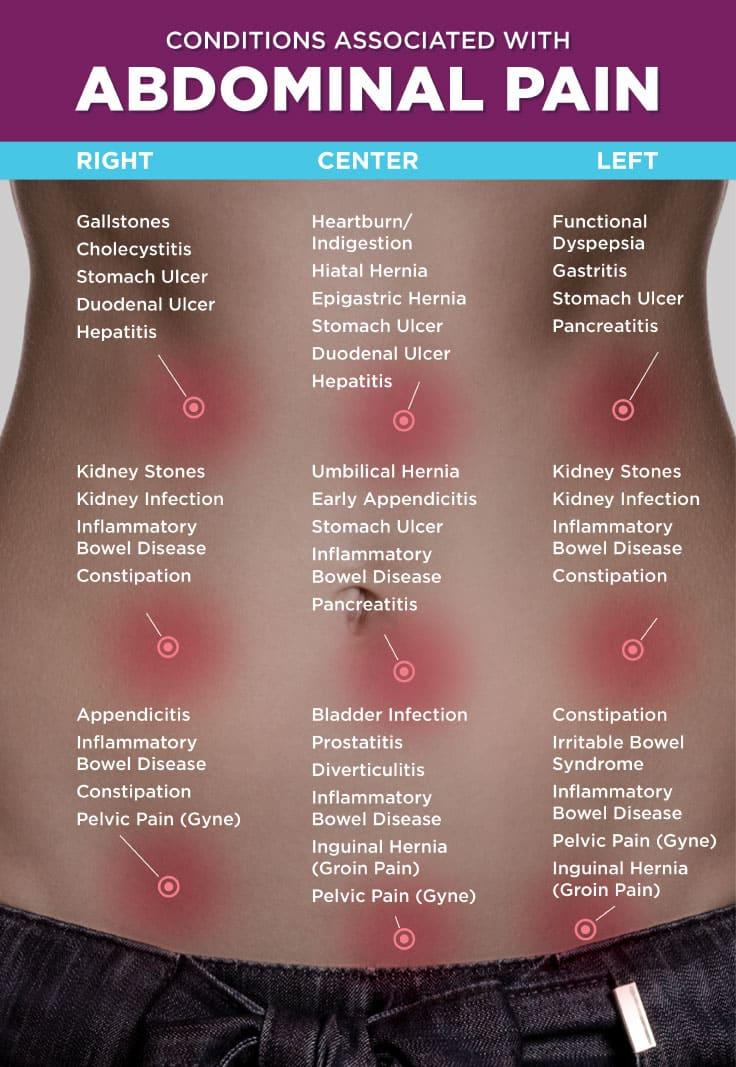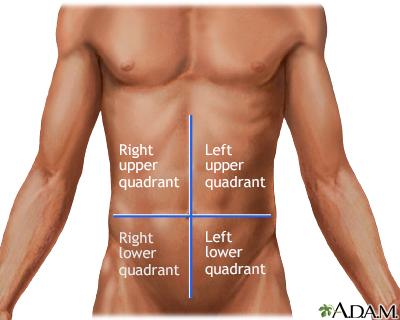Understanding Lower Stomach Pain: Unraveling the Discomfort Beneath
Lower stomach pain is a common yet often perplexing experience that can affect individuals of all ages and backgrounds. As we navigate our daily lives, the sudden onset of discomfort in the abdominal region can be alarming, prompting a whirlwind of questions and concerns. Is it a sign of something serious, or merely a fleeting inconvenience? In this article, we will explore the various causes, symptoms, and potential treatments for lower stomach pain. By shedding light on this universal yet misunderstood ailment, we aim to empower readers with knowledge and insights, ultimately easing the worry that often accompanies abdominal discomfort. Join us as we embark on a journey through the intricate landscape of lower stomach pain, uncovering the truths behind its many faces.
Understanding the Causes of Lower Stomach Pain
Lower stomach pain can arise from a variety of sources, each with its own set of implications. Understanding these causes is essential for determining the appropriate course of action. Some common factors include:
- Digestive Issues: Conditions such as irritable bowel syndrome (IBS) and constipation can lead to discomfort in the lower abdomen.
- Gynecological Problems: In women, issues like ovarian cysts, endometriosis, and menstrual cramps can manifest as lower stomach pain.
- Urinary Tract Infections: UTIs can cause significant discomfort and may also be accompanied by a frequent urge to urinate.
- Hernias: These occur when an organ pushes through an opening in the muscle or tissue, resulting in localized pain.
Additionally, factors like lifestyle choices and underlying medical conditions can exacerbate these pains. Here’s a brief overview of less common causes:
| Cause | Description |
|---|---|
| Appendicitis | Inflammation of the appendix, often requiring surgical intervention. |
| Pelvic Inflammatory Disease | An infection of the female reproductive organs that can cause severe pain. |
| Diverticulitis | Inflammation or infection of small pouches that can develop in the intestines. |
Identifying Symptoms: When to Seek Medical Attention
Lower stomach pain can manifest in various ways, and understanding the symptoms associated with it is crucial for determining when to seek medical care. If you experience sharp, persistent, or severe pain, this may indicate a more serious underlying condition. Other symptoms to watch for include:
- Nausea or vomiting
- Fever or chills
- Changes in bowel habits (diarrhea or constipation)
- Unexplained weight loss
- Blood in stool or urine
In some cases, lower stomach pain can be accompanied by symptoms that suggest a medical emergency. It’s essential to stay vigilant and seek immediate attention if you notice:
| Symptom | Action |
|---|---|
| Severe pain that worsens over time | Visit the emergency room |
| Accompanied by chest pain | Call emergency services |
| Signs of dehydration (dry mouth, dizziness) | Seek medical help |
Recognizing these signs early can significantly impact treatment outcomes, making it vital to listen to your body and respond appropriately. If you’re ever in doubt about your symptoms, err on the side of caution and consult a healthcare professional.
Lifestyle Factors Influencing Lower Abdominal Discomfort
The connection between lifestyle choices and lower abdominal discomfort is often underestimated. Factors such as diet, exercise, and stress management play significant roles in how our bodies respond to various stimuli. A diet high in processed foods, sugars, and trans fats can lead to inflammation and discomfort, while a fiber-rich diet can promote digestive health. Additionally, hydration is key; inadequate water intake can result in constipation, which often exacerbates abdominal pain. To mitigate these issues, consider incorporating the following habits:
- Eat whole foods: Prioritize fruits, vegetables, whole grains, and lean proteins.
- Stay active: Regular exercise aids digestion and reduces stress.
- Manage stress: Practice relaxation techniques such as yoga or meditation.
Sleep also holds a crucial place in the equation; inadequate rest can affect hormone levels and digestive processes. Understanding how various activities and habits impact your body can serve as a guide toward a healthier lifestyle. Below is a quick reference table outlining some common lifestyle factors and their potential effects on abdominal discomfort:
| Lifestyle Factor | Potential Effect |
|---|---|
| Diet High in Processed Foods | Increased inflammation and discomfort |
| Low Fiber Intake | Higher likelihood of constipation |
| Inadequate Hydration | Contributes to digestive issues |
| High Stress Levels | Can lead to gastrointestinal disturbances |
| Poor Sleep Quality | Disrupts digestion and hormone balance |
Holistic Approaches to Manage and Alleviate Pain
Exploring the body-mind connection can unveil effective techniques for relieving discomfort. Mindfulness practices, such as meditation and deep breathing, encourage individuals to focus on the present moment, reducing stress and tension that can exacerbate physical pain. Integrating gentle yoga or stretching can also promote flexibility and improve circulation, targeting areas of discomfort in the lower abdomen. Additionally, aromatherapy using essential oils like lavender or chamomile can create a calming atmosphere, which may help soothe both mind and body.
Nutrition plays a pivotal role in managing pain. Incorporating anti-inflammatory foods such as leafy greens, nuts, and fatty fish can support overall health and alleviate discomfort. Maintaining hydration is equally important; drinking sufficient water helps the digestive system function optimally, potentially reducing bloating and cramping. Here’s a quick reference table to highlight some beneficial foods:
| Food | Benefits |
|---|---|
| Leafy Greens | Rich in vitamins, helps reduce inflammation |
| Fatty Fish | High in omega-3 fatty acids, can lower pain levels |
| Nuts | Contains healthy fats and protein, promotes satiety |
| Ginger | Natural anti-inflammatory, may ease digestive issues |
Dietary Adjustments for Digestive Health
Making thoughtful dietary adjustments can significantly enhance digestive health and alleviate discomfort associated with lower stomach pain. Start by incorporating a variety of fiber-rich foods into your meals, as they help promote regular bowel movements and prevent constipation. Consider including:
- Whole grains: Oats, quinoa, and brown rice
- Fruits: Apples, berries, and pears
- Vegetables: Broccoli, carrots, and leafy greens
- Legumes: Lentils, chickpeas, and black beans
Additionally, it’s essential to stay hydrated and limit the intake of foods that can irritate your digestive tract. Consider reducing consumption of:
- Processed foods: High in sugar and unhealthy fats
- Spicy dishes: May cause discomfort for some individuals
- Dairy products: Can be problematic for those who are lactose intolerant
- Caffeinated beverages: Can lead to increased stomach acidity
| Food Category | Recommendations |
|---|---|
| Fruits | Bananas, Papayas |
| Vegetables | Sweet Potatoes, Cucumbers |
| Proteins | Lean meats, Fish |
| Snacks | Nuts, Yogurt (if tolerated) |
Preventive Measures: Tips for Maintaining Abdominal Wellness
Maintaining abdominal wellness is essential for overall health and can help prevent discomfort in the lower stomach area. To ensure your abdomen remains in optimal condition, consider incorporating the following practices into your daily routine:
- Stay Hydrated: Drinking sufficient water aids digestion and helps prevent bloating.
- Balanced Diet: Focus on fiber-rich foods such as fruits, vegetables, and whole grains to promote healthy digestion.
- Regular Exercise: Engaging in physical activity strengthens abdominal muscles and helps maintain a healthy weight.
- Mindful Eating: Eating slowly and chewing thoroughly can reduce the likelihood of indigestion and discomfort.
- Stress Management: Incorporate relaxation techniques like yoga or meditation to alleviate stress, which can negatively impact digestive health.
In addition to these lifestyle adjustments, regular health screenings can play a vital role in preventing abdominal issues. Consider the following tips for monitoring your abdominal health:
| Screening Type | Recommended Frequency |
|---|---|
| Physical Examination | Annually |
| Colonoscopy | Every 10 years (starting at age 45) |
| Ultrasound (if needed) | As recommended by a physician |
By adopting these preventive measures and maintaining awareness of your abdominal health, you can significantly reduce the risk of experiencing lower stomach pain and promote overall well-being.
Q&A
Q&A on Lower Stomach Pain
Q: What is lower stomach pain?
A: Lower stomach pain, often referred to as lower abdominal pain, is discomfort or pain that occurs in the lower region of the abdomen. This area houses various organs, including the intestines, bladder, and reproductive organs, which can lead to a range of potential issues when discomfort arises.
Q: What common conditions may cause lower stomach pain?
A: Lower stomach pain can stem from various conditions. Common culprits include digestive issues like gas, constipation, or irritable bowel syndrome (IBS). In women, menstrual cramps, ovarian cysts, or conditions like endometriosis are possible causes. In men, conditions such as prostatitis may also be a factor. Additionally, appendicitis, hernias, or urinary tract infections can manifest as lower abdominal pain.
Q: How can I determine the cause of my lower stomach pain?
A: It’s important to consider accompanying symptoms. Is there nausea? Diarrhea? Fever? These details can help pinpoint the issue. A healthcare professional can offer an accurate diagnosis through a physical examination, medical history, and possibly additional tests, such as imaging or blood work.
Q: When should I seek medical attention for lower stomach pain?
A: While occasional discomfort may resolve on its own, you should seek medical attention if the pain is severe, persistent, or accompanied by other concerning symptoms like vomiting, high fever, or blood in stool. Early intervention can be crucial in addressing more serious conditions.
Q: What remedies exist for mild lower stomach pain?
A: For mild cases, various home remedies may provide relief. Over-the-counter pain relievers, heat pads, and herbal teas like chamomile or peppermint can soothe discomfort. Staying hydrated and consuming a balanced diet may also help alleviate symptoms caused by digestive issues.
Q: Can lifestyle changes help prevent lower stomach pain?
A: Absolutely! Incorporating regular exercise, managing stress, and maintaining a healthy diet rich in fiber can significantly reduce the risk of experiencing lower stomach pain. Keeping a food diary may help identify any specific triggers related to diet.
Q: Are there any misconceptions about lower stomach pain?
A: Yes, one prevalent misconception is that all lower stomach pain is serious or indicative of a severe condition. While some causes are serious, many instances of lower abdominal pain are benign and temporary. It’s essential to avoid jumping to conclusions and consult with a healthcare professional for clarity.
Q: How does lower stomach pain vary between genders?
A: Lower stomach pain can present differently between genders largely due to the distinct reproductive systems. Women may experience pain related to menstrual cycles or pregnancy, while men may be more prone to issues related to the prostate. However, both genders can experience similar digestive or urinary-related discomfort.
Q: What is the bottom line about lower stomach pain?
A: Lower stomach pain is a common issue that can arise from various causes, ranging from mild to serious. Awareness of symptoms, prompt action when necessary, and proactive lifestyle choices can help manage and potentially prevent future discomfort. Always consult a healthcare provider for personalized guidance and treatment options.
In Retrospect
lower stomach pain, while often a common discomfort, can be an intricate puzzle of symptoms that deserves our attention. Whether it arises from benign causes like gas and indigestion or signals something more complex, understanding the nuances of your body is crucial. As we navigate this often-overlooked aspect of health, remember that while the discomfort may be temporary, the knowledge gained can be empowering. Listen to your body, consult with healthcare professionals, and seek clarity in the face of uncertainty. Ultimately, prioritizing your well-being and fostering a proactive approach to health will not only ease the discomfort but also pave the way for a more informed and healthier future.
